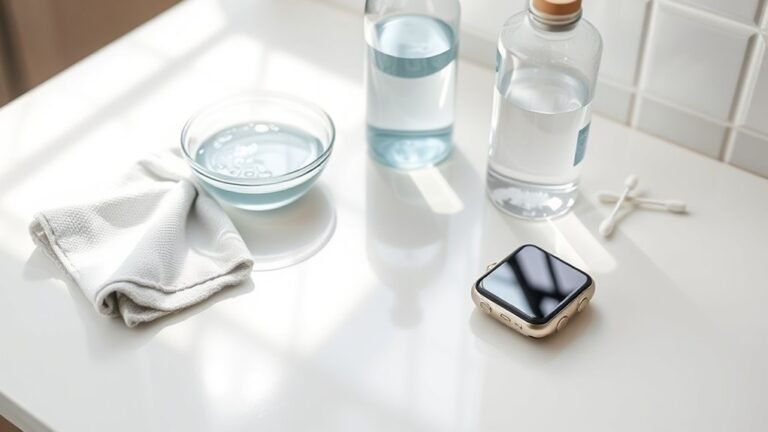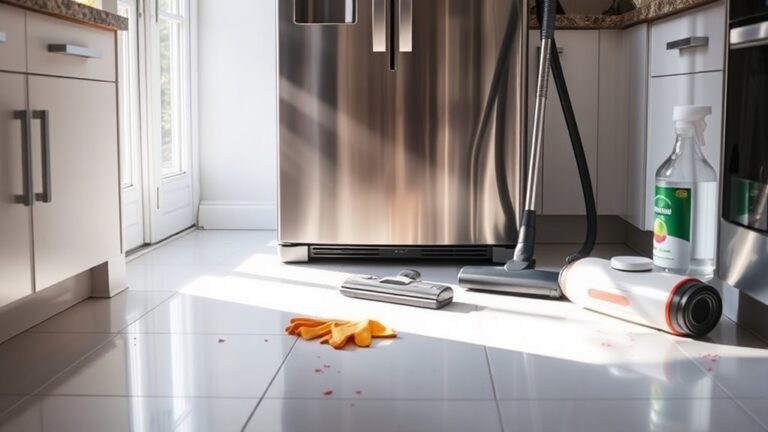Best Way to Sanitize Your Remote
You should sanitize your remote regularly to keep germs like E. coli and cold viruses at bay. Use disinfectant wipes or a microfiber cloth dampened with at least 70% isopropyl alcohol for safe and effective cleaning. Focus on buttons and crevices using a soft brush or cotton swab. Doing this once a week helps reduce illness risk, especially if multiple people use the remote. Keep going to discover practical tips and the best cleaning materials.
Why Regular Cleaning of Your Remote Is Essential

Although you might not think about it often, your remote control can harbor a surprising amount of germs and bacteria since you handle it frequently throughout the day. Prioritizing remote hygiene is essential to protect your health and maintain a clean living space. Neglecting this simple task can increase your risk of illness, as germs transfer from the remote to your hands and face. You deserve the freedom to enjoy your home without worrying about unseen health impacts. Regular cleaning breaks the cycle of contamination, keeping harmful microbes at bay and promoting well-being. By taking a few minutes to sanitize your remote, you empower yourself to live healthier and more independently, free from preventable infections linked to everyday objects you often overlook.
Common Germs Found on Remote Controls
You might be surprised to learn that your remote control can harbor bacteria like E. coli and Staphylococcus. These germs can easily transfer to your hands and face, increasing the risk of illness. Knowing what’s on your remote is the first step to keeping it clean and safe.
Types of Remote Germs
Since remote controls are handled frequently and often shared, they can harbor a variety of germs that you might not expect. Understanding the main germ types on your remote is key to effective remote hygiene. Common culprits include bacteria like Staphylococcus aureus, which can cause skin infections, and E. coli, often linked to fecal contamination. Viruses such as the common cold and flu can also linger on surfaces, waiting for the next touch to spread. Fungi, though less common, may appear in humid environments. Knowing these germ types empowers you to take control over your space and keep your remote clean. Staying proactive with regular sanitation helps protect your freedom to enjoy entertainment without unwanted germs tagging along.
Germ Transmission Risks
When you pick up your remote, invisible germs can easily transfer to your hands and then to your face or other surfaces. Remote controls are notorious germ hotspots because they’re handled frequently but rarely cleaned. Common transmission pathways include touching your mouth, nose, or eyes after using the remote, or passing germs onto shared surfaces like couches and coffee tables. Bacteria like E. coli, Staphylococcus, and even cold viruses can linger on these devices, increasing your risk of illness. To maintain your freedom from sickness, it’s essential to understand these risks and take control by regularly sanitizing your remote. Being mindful of germ transmission pathways helps you stay healthy without sacrificing comfort or convenience in your daily routine.
Materials You Need for Effective Sanitization

A few simple materials are all it takes to effectively sanitize your remote and keep germs at bay. You’ll want to gather some reliable cleaning products like isopropyl alcohol (at least 70%), disinfectant wipes, or antibacterial sprays. These are powerful enough to eliminate harmful bacteria without damaging your device. Along with that, essential sanitizing tools such as microfiber cloths and cotton swabs help you reach every nook and cranny. Avoid harsh chemicals or abrasive materials that could harm the remote’s surface. Having these items ready gives you the freedom to maintain a clean, germ-free remote anytime. With the right cleaning products and sanitizing tools, you can confidently reduce contamination risks and enjoy your entertainment without worry.
Step-by-Step Guide to Cleaning Your Remote Safely
Cleaning your remote safely involves just a few straightforward steps that guarantee thorough sanitization without causing damage. First, remove the batteries to prevent any electrical issues during cleaning. Use a soft, lint-free cloth slightly dampened with a mild cleaning solution to wipe down the surface gently. Pay attention to buttons and crevices, using a cotton swab or soft brush to reach tight spots. Avoid excess moisture to protect internal components. After cleaning, let the remote air dry completely before reinserting the batteries. These remote care cleaning techniques help maintain hygiene while preserving your device’s functionality. Following this simple process gives you freedom from worry, ensuring your remote stays clean, safe, and ready for use whenever you need it.
Using Disinfectant Wipes vs. Homemade Solutions

How do you decide between disinfectant wipes and homemade solutions for sanitizing your remote? Disinfectant wipes offer convenience and proven disinfectant efficiency, killing germs quickly with minimal effort. They’re ready to use, portable, and often formulated to be safe on electronics. On the other hand, homemade solutions give you control over ingredients, letting you avoid harsh chemicals and tailor mixtures to your preference. A simple mix of isopropyl alcohol and water can be just as effective if applied correctly. Choosing between the two depends on your lifestyle—if freedom means quick and reliable cleaning, wipes are your go-to. But if you value natural ingredients and DIY control, homemade solutions can provide effective sanitation without sacrificing safety or efficiency. Either way, your remote stays clean and ready to use.
Tips to Prevent Remote Contamination
To keep your remote clean, you should stick to a regular cleaning routine and avoid sharing it with others whenever possible. Using protective covers can also help minimize contamination. These simple steps can make a big difference in maintaining hygiene.
Regular Cleaning Routine
Since your remote is one of the most frequently touched devices in your home, establishing a regular cleaning routine is essential to keep germs at bay. You’ll want to stick to an effective cleaning frequency—ideally once a week or after any illness in the household. Here are the best practices to maintain freedom from contamination:
- Use a microfiber cloth lightly dampened with a mix of water and isopropyl alcohol to wipe down surfaces.
- Clean between buttons with a soft brush or cotton swab to remove hidden dirt and grime.
- Allow the remote to air dry completely before using to avoid damage.
Following these steps consistently gives you control over your environment, letting you enjoy your devices without worry.
Avoid Shared Usage
Although sharing a remote might seem harmless, it can quickly spread germs among users. When you use shared devices like remotes, you increase the risk of transferring bacteria and viruses. To protect your personal hygiene and health, try to limit how often you share your remote with others. If you live with family or roommates, consider assigning each person their own remote or designate specific times for use to reduce cross-contamination. By taking control of your environment and minimizing contact with shared devices, you’re creating a safer space that supports your freedom to enjoy entertainment without worry. Remember, maintaining good personal hygiene alongside avoiding shared remote usage is key to keeping germs at bay and staying healthy.
Use Protective Covers
When you want to keep your remote clean without constant wiping, using a protective cover is a smart move. These covers provide protective benefits that guard against dirt, spills, and germs, giving you more freedom to relax without worry. Plus, they’re designed for easy installation, so you can have one on your remote in seconds.
Here’s why you should consider a protective cover:
- Hygiene: Keeps germs off your remote, reducing contamination risks.
- Durability: Protects against wear and tear, extending your remote’s life.
- Convenience: Easy to remove and clean, saving you time and effort.
With these covers, you maintain control over cleanliness while enjoying effortless protection.
How Often Should You Sanitize Your Remote?
Regularly sanitizing your remote is essential to keep germs at bay, especially if multiple people use it daily. To maintain a healthy environment without feeling restricted, follow frequency recommendations suggesting you clean your remote at ideal intervals—typically once a week. However, if you’re feeling under the weather or hosting guests, increasing the frequency to every couple of days makes sense. Remember, your remote is a high-touch surface, so sticking to these intervals keeps harmful bacteria from spreading while giving you freedom to enjoy your space worry-free. By establishing this simple routine, you take control of your health without sacrificing convenience, ensuring your remote stays as clean as your lifestyle demands.
Frequently Asked Questions
Can UV Light Effectively Sanitize Remote Controls?
Did you know your remote control can harbor up to 10 times more bacteria than a toilet seat? When it comes to UV effectiveness, UV light can indeed sanitize your remote safely by killing germs without harsh chemicals. Using UV light keeps your remote safety intact, letting you enjoy freedom from worry and grime. So, if you want a quick, chemical-free clean, UV sanitizing is a smart, liberating choice for your devices.
Is It Safe to Use Alcohol Sprays on All Remote Types?
You’ll want to be cautious using alcohol sprays on all remotes since the alcohol concentration matters. High concentrations (above 70%) can damage remote materials like plastic or rubber buttons. Instead, opt for isopropyl alcohol around 70% and spray it on a microfiber cloth—not directly on the remote—to keep it safe. This way, you get effective sanitizing without risking damage, letting you keep your remote clean and functional without restrictions.
How Do Moisture-Sensitive Remotes Get Sanitized Without Damage?
If your remote is moisture-sensitive, you’ll want to avoid sprays or wipes that can cause damage. Instead, focus on dry methods for remote maintenance, like using a microfiber cloth to gently remove germs. You could also use a slightly dampened cloth with moisture protection in mind—just make sure it’s not dripping wet. This way, you maintain your remote’s freedom from damage while keeping it clean and functional.
Can Silicone Remote Covers Reduce Germ Buildup?
Think of silicone remote covers as a protective shield, like armor for your gadget. They offer silicone benefits by creating a barrier that helps with germ prevention, reducing how many germs settle on your remote. You’ll find they’re easy to clean, letting you wipe away dirt without worry. Using one means you’re free to relax, knowing your remote stays cleaner and safer for everyday use.
Are There Any Sanitizers Specifically Designed for Electronic Devices?
You’ll find device sanitizers made just for electronics, designed to clean without harming screens or buttons. Electronic wipes are a popular choice—they’re pre-moistened with gentle, alcohol-based solutions that kill germs while keeping your devices safe. Using these lets you keep your gadgets fresh and germ-free without fuss, giving you the freedom to use them confidently wherever you go. Just make sure the wipes say they’re safe for electronics to avoid damage.






